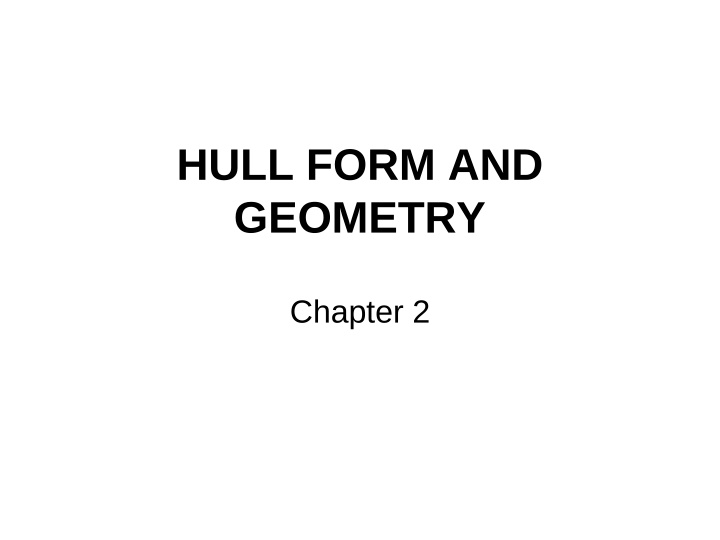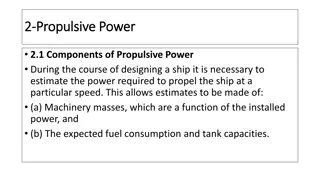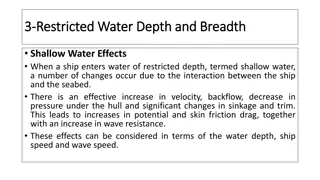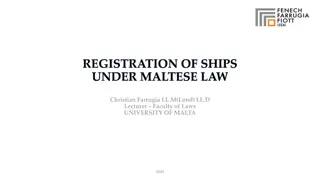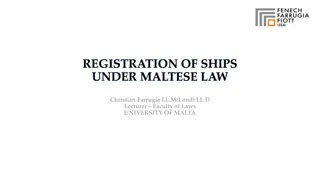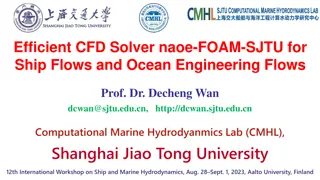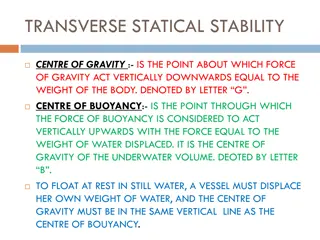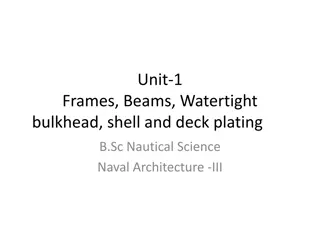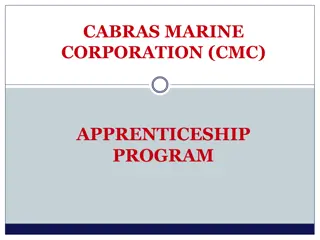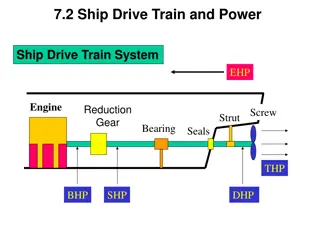Ship Classification and Design Factors Overview
Explore the categorization and classification of ships based on usage and support type. Delve into the factors influencing ship design such as size, speed, payload, range, seakeeping, maneuverability, stability, and special capabilities. Learn about the various methods of ship classification, including aerostatic, hydrodynamic, and hydrostatic support types. Discover different types of vessels like merchant ships, naval vessels, combatants, recreational vessels, and more. Gain insights into aerostatic support vessels like Air Cushion Vehicles (ACV) and Surface Effect Ships (SES) and their unique characteristics.
Download Presentation

Please find below an Image/Link to download the presentation.
The content on the website is provided AS IS for your information and personal use only. It may not be sold, licensed, or shared on other websites without obtaining consent from the author.If you encounter any issues during the download, it is possible that the publisher has removed the file from their server.
You are allowed to download the files provided on this website for personal or commercial use, subject to the condition that they are used lawfully. All files are the property of their respective owners.
The content on the website is provided AS IS for your information and personal use only. It may not be sold, licensed, or shared on other websites without obtaining consent from the author.
E N D
Presentation Transcript
HULL FORM AND GEOMETRY Chapter 2
Intro to Ships and Naval Engineering (2.1) Factors which influence design: Size Speed Payload Range Seakeeping Maneuverability Stability Special Capabilities (Amphib, Aviation, ...) Compromise is required!
Classification of Ship by Usage Merchant Ship Naval & Coast Guard Vessel Combatants and Auxiliaries Recreational Vessel Utility Tugs Research & Environmental Ship Ferries
Categorizing Ships (2.2) Methods of Classification: Ship vs Boat small vessel that can fit in a larger one boat vessel with CO/ permanent crew ship submarine boat Physical Support / Broad Categories: Aerostatic (Aerodynamic) Hydrodynamic Hydrostatic
Classification of Ship by Support Type Aerostatic Support - Air Cushion Vehicles (ACV) Hovercraft / LCACs - Surface Effect Ships (SES) / Captured Air Bubble (CAB) Hydrodynamic Support (Bernoulli) (Hydro Water Dynamic Movement) - Planing Hull - Hydrofoil Hydrostatic Support (Archimedes) (Hydro Water Static At Rest) - Conventional Ship - Catamaran - Small Waterplane Area Twin Hull (SWATH) - Deep Displacement Submarine - Submarine - ROV
Aerostatic Support Vessel rides on a cushion of air. Lighter weight, higher speeds, smaller load capacity. Air Cushion Vehicles (ACV) - LCAC: Opens up 75% of littoral coastlines, versus about 12% for displacement Surface Effect Ships (SES): Fast, directionally stable, but not amphibious
Aerostatic Support Supported by cushion of air Air Cushion Vehicles (ACV) hull material : rubber propeller : placed on the deck amphibious operation Surface Effect Ships (SES) side hull : rigid wall bow : skirt propulsion system : placed under the water water jet propulsion supercavitating propeller not amphibious operation
Aerostatic Support English Channel Ferry - Hovercraft
Aerostatic Support SES Ferry NYC SES Fireboat E
Hydrodynamic Support Supported by moving water At slower speeds, they are hydrostatically supported Planing Vessels - Hydrodynamics pressure developed on the hull at high speeds to support the vessel. Limited loads, high power requirements. Hydrofoils - Supported by underwater foils, like wings on an aircraft. Dangerous in heavy seas. No longer used by USN.
Hydrodynamic Support Planing Hull - supported by the hydrodynamic pressure developed under a hull at high speed - V or flat type shape - Commonly used in pleasure boat, patrol boat, missile boat, racing boat Destriero
Hydrodynamic Support Hydrofoil - supported by a hydrofoil, like wing on an aircraft - fully submerged hydrofoil ship - surface piercing hydrofoil ship Hydrofoil Ferry
Hydrostatic Support Displacement Ships float by displacing their own weight in water Includes nearly all traditional military and cargo ships and 99% of ships in this course Small Waterplane Area Twin Hull ships (SWATH) Submarines (when surfaced)
Hydrostatic Support The Ship is supported by its buoyancy. (Archimedes Principle) ***** Archimedes Principle : An object partially or fully submerged in a fluid will experience a resultant vertical force equal in magnitude to the weight of the volume of fluid displaced by the object ***** The buoyant force of a ship is calculated from the displaced volume by the ship
Hydrostatic Support Mathematical Form of Archimedes Principle Resultant Weight Resultant Buoyancy
Hydrostatic Support Displacement Ship - conventional type of ship - carries high payload - low speed SWATH - small waterplane area twin hull (SWATH) - low wave-making resistance - excellent roll stability - large open deck - disadvantage : deep draft and cost Catamaran/Trimaran - twin hull - other characteristics are similar to the SWATH Submarine - on the surface
Hydrostatic Support Some submarines are being designed for the purpose of viewing underwater life and reefs, for example. Unmanned submersibles have been used for scientific purposes, such as finding the Titanic, as well as a wide variety of oceanographic research. Submarine Week (Chapter 10) End of Course
2.3 Ship Hull Form and Geometry The ship is a 3-dimensional shape: Data in x, y, and z directions is necessary to represent the ship hull Table of Offsets Lines Drawings: - Body Plan (front view) - Sheer Plan (side view) - Half Breadth Plan (top view)
Hull Form Representation Lines Drawings: Traditional graphical representation of the ship s hull form Lines Half-Breadth Sheer Plan Body Plan
Hull Form Representation Body Plan (Front / End) Half-Breadth Plan (Top) Sheer Plan (Side) Lines Plan
** Body Plan ** - Intersection of planes to define section line - Sectional lines show the true shape of the hull form - Slices of Bread are called stations - Forward sections from amidships : Right Side - Aft sections from amidships : Left Side - Middle slice = Midships 3 2 1 5 4 3 5 1 3 4 2 3
Sheer Plan - Intersection of planes (buttock lines) parallel to the centerline plane - Side View - Slices are called buttock lines - Middle slice = centerline 2 1 1 2
** Half-Breadth Plan ** - Intersection of planes (waterlines) parallel to the baseline (keel). - Half and Half on top of coffee - Typically just one side due to symmetry - Slices are called waterlines 3 2 1 3 2 1
2.5 (Preview) Basic Dimensions and Hull Form Characteristics AP FP DWL LOA LOA(length over all) : Overall length of the vessel. Bow to Stern DWL(design waterline) : Water line where the ship is designed to float FP(forward perpendicular) : imaginary vertical line where the bow intersects the DWL AP(aft perpendicular) : imaginary vertical line located at either the rudder stock or intersection of the stern with DWL Stations : parallel planes from forward to aft, evenly spaced (like bread).Normally an odd number to ensure an even number of blocks.
Basic Dimensions and Hull Form Characteristics FP AP Shear DWL Lpp Lpp (length between perpendicular) : horizontal distance from FP and AP Amidships : the point midway between FP and AP ( ) Midships Station Shear : longitudinal curvature given to deck
Table of Offsets (2.4) Used to convert graphical information to a numerical representation of a three dimensional body Lists the distance from the center plane to the outline of the hull at each station and waterline There is enough information in the Table of Offsets to produce all three lines plans Numerical coordinates for the 3 (Body, Sheer, and Half-Breadth) Plans
Table of Offsets The distances from the centerplane are called the offsets or half-breadth distances.
Table of Offsets Example: Given the following table of offsets, draw the body plan for stations 0, 2, 8 and 10
0 2 10
2.5 Basic Dimensions and Hull Form Characteristics FP AP DWL LOA LOA(length over all) : Overall length of the vessel. Bow to Stern DWL(design waterline) : Water line where the ship is designed to float FP(forward perpendicular) : imaginary vertical line where the bow intersects the DWL AP(aft perpendicular) : imaginary vertical line located at either the rudder stock or intersection of the stern with DWL Stations : parallel planes from forward to aft, evenly spaced (like bread).Normally an odd number to ensure an even number of blocks.
Basic Dimensions and Hull Form Characteristics FP AP Shear DWL Lpp Lpp (length between perpendicular) : horizontal distance from FP and AP Amidships : the point midway between FP and AP ( ) Midships Station Shear : longitudinal curvature given to deck
Basic Dimensions and Hull Form Characteristics Beam: B View of midship section WL Depth: D Draft: T CL Depth(D): vertical distance measured from keel to deck taken at amidships and deck edge in case the ship is cambered on the deck. Draft(T) : vertical distance from keel to the water surface, wet Beam(B) : transverse distance across the each section, width Breadth(B) : transverse distance measured amidships
Basic Dimensions and Hull Form Characteristics Beam: B Camber View of midship section Freeboard WL Depth: D Draft: T Keel (K) CL Freeboard : distance from depth to draft (reserve buoyancy), dry Keel (K) : locate the bottom of the ship Camber : transverse curvature given to deck
Basic Dimensions and Hull Form Characteristics Flare Tumblehome Flare: outward curvature of ship s hull surface above the waterline - Wave piercing, resistance to roll, available deck space Tumblehome: opposite of flare Zumwalt, DDG 1000 - - Reduce Radar Cross Section (less mass above waterline) Sailing Yachts, Submarines
Example Problem Label the following: R. Distance between N. & O. ___=______ _______ ______________ I. Viewed from this direction ____-_______ Plan G. Viewed from this direction ____ Plan P. Middle ref plane for longitudinal measurements _________ z S. Width of the ship ____ A.(translation) _____ x C. (translation) _____ E. (rotation) _____/____ N. Forward ref plane for longitudinal measurements _______ _____________ Q. Longitudinal ref plane for transverse measurements __________ J. _______ Line M. Horizontal ref plane for vertical measurements ________ O. Aft ref plane for longitudinal measurements ___ _____________ H. Viewed from this direction _____ Plan D. (rotation) ____/____/____ y L. _____line B. (translation) F. (rotation) K. _______ Line
Example Answer R. Distance between N. & O. Lpp=Length between Perpendiculars Label the following: I. Viewed from this direction Half-Breadth Plan G. Viewed from this direction Body Plan P. Middle ref plane for longitudinal measurements Amidships z S. Width of the ship Beam A.(translation) Surge x C. (translation) Heave E. (rotation) Pitch/Trim N. Forward ref plane for longitudinal measurements Forward Perpendicular Q. Longitudinal ref plane for transverse measurements Centerline J. Section Line M. Horizontal ref plane for vertical measurements Baseline O. Aft ref plane for longitudinal measurements Aft Perpendicular H. Viewed from this direction Sheer Plan D. (rotation) Roll/List/Heel y B. (translation) Sway L. Waterline F. (rotation) Yaw K. Buttock Line
2.6 Centroids Centroid - Area - Mass - Volume - Force - Buoyancy (LCB or TCB) - Floatation (LCF or TCF) Apply the Weighted Average Scheme or Moment =0
Centroids Centroid The geometric center of a body Center of Mass - A single point location of the mass Better known as the Center of Gravity (CG) CG and Centroids are only in the same place for uniform (homogenous) mass!
